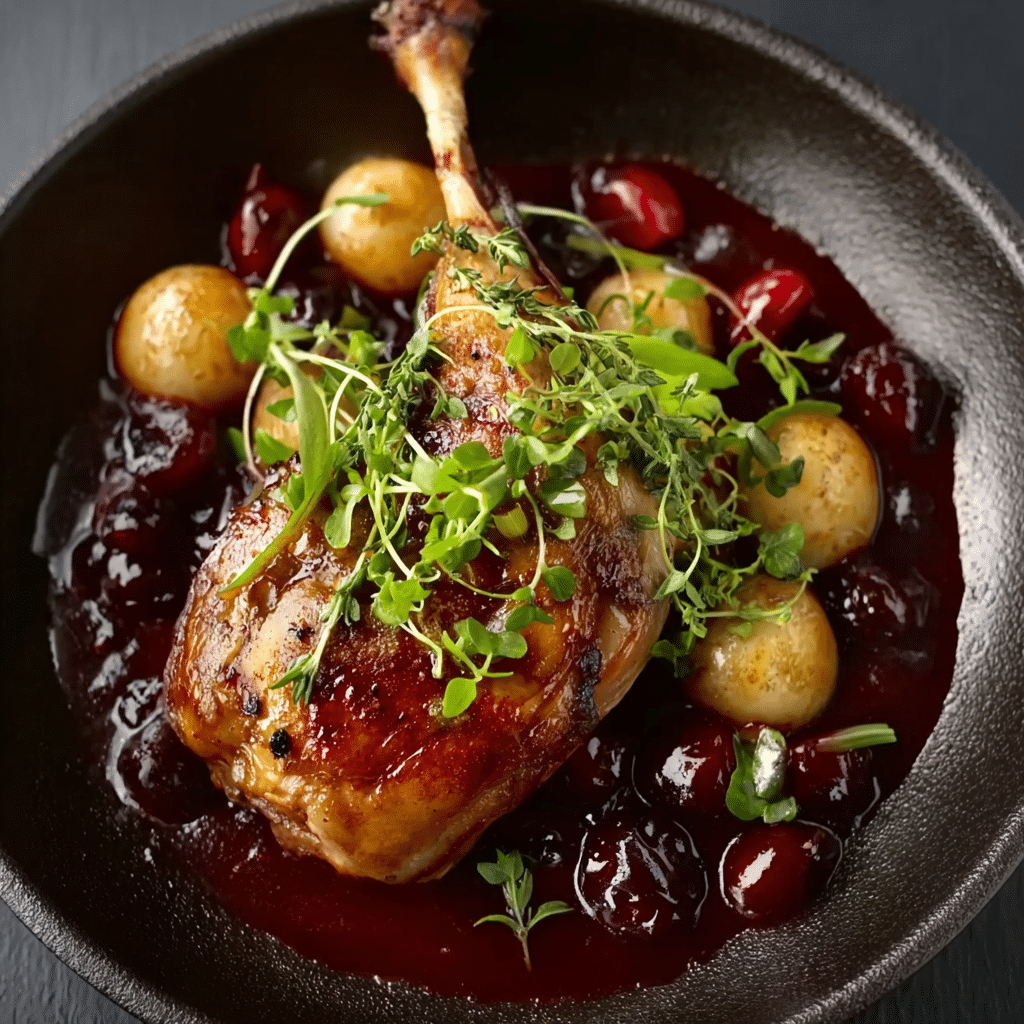Experience the magic of French-inspired indulgence with this Duck Confit with Cherry Reduction. Tender duck legs slow-cooked in their own fat become fall‑apart soft, crisped to golden swoon‑worthy perfection, and dressed in a glossy cherry sauce that dances between tart and sweet.
This dish transforms a weekend dinner or romantic gathering into a restaurant-worthy moment. With roasted baby potatoes, vibrant sautéed greens, and a final flourish of microgreens, it’s both visually stunning and deeply satisfying.
Full Recipe
Ingredients:
-
2 duck leg quarters
-
4 cups duck fat
-
2 tbsp coarse sea salt
-
1 tsp freshly cracked black pepper
-
2 sprigs fresh thyme
-
2 garlic cloves, crushed
-
1 cup fresh cherries, pitted
-
½ cup dry red wine (Pinot Noir or Merlot)
-
1 tbsp honey
-
1 tbsp balsamic vinegar
-
½ tsp Dijon mustard
-
1 tbsp unsalted butter
-
1 tbsp olive oil
-
½ lb baby potatoes, halved
-
2 cups sautéed greens (spinach or kale)
-
Microgreens or edible flowers for garnish
Directions:
-
Cure the duck: Rub duck with salt, pepper, thyme & garlic. Cover and refrigerate 12–24 hr.
-
Confit: Preheat oven to 225 °F (110 °C). Rinse cure; pat dry. Submerge duck in duck fat in Dutch oven; cover & bake 2½–3 hr until meat is tender.
-
Crisp the skin: Remove duck; pat dry. In a skillet over medium-high, sear skin‑side down until golden and crispy.
-
Cherry reduction: In saucepan, combine cherries, wine, honey, balsamic & mustard. Simmer 10–15 min until thick. Strain (optional), then whisk in butter.
-
Roast potatoes: Preheat oven to 400 °F (200 °C). Toss potatoes with olive oil, salt, pepper. Roast 20–25 min until golden.
-
Sauté greens: Quickly cook greens in pan until wilted; season to taste.
-
Plate: Spoon cherry sauce in a swoosh. Arrange crispy duck atop, flank with potatoes and greens. Garnish with microgreens or edible flowers.
Prep Time: 15 min | Cooking Time: 3 hr | Total Time: 3 hr 15 min | Kcal: ~720 kcal per serving | Servings: 2
A Celebration of Tradition and Modern Flair
Duck confit is one of the most iconic dishes in French cuisine, celebrated for its melt-in-your-mouth texture and savory richness. Originating from the Gascony region, this technique was initially developed as a method of preservation, where duck legs were salt-cured and slowly cooked in their own fat. Today, it’s considered a gourmet staple, prized for its deep flavor and luxurious mouthfeel. This recipe elevates the classic with a fresh cherry reduction, bringing a modern, seasonal flair to the plate. The sweet-tart balance of the cherries cuts through the richness of the duck, creating harmony in every bite.
Why Duck Confit Deserves the Spotlight
Duck is often overlooked in everyday home cooking due to its perceived complexity and richness, but confit proves that with a little patience and care, it’s more accessible than most think. Unlike roasted or pan-seared duck, confit provides unmatched tenderness. The process is forgiving—slow cooking ensures the meat doesn’t dry out, and the result is incredibly succulent meat that literally falls off the bone. When crisped before serving, it adds the final touch: that addictive golden, crackly skin.
The Role of the Cherry Reduction
Cherries and duck are a match made in culinary heaven. The cherry reduction in this dish doesn’t just play the role of a sauce—it’s a full-fledged flavor enhancer. Fresh cherries are simmered with red wine, honey, balsamic vinegar, and Dijon mustard to create a glossy, sweet-tart glaze that cuts through the fattiness of the confit and livens up the palate. This sauce brings an element of refinement to the dish and adds beautiful depth through layers of acidity, fruitiness, and complexity from the wine.
How Seasonal Ingredients Elevate the Dish
Utilizing fresh cherries when in season gives the dish a special edge. Seasonal ingredients are not only fresher and more flavorful, but they also align your cooking with nature’s rhythm. Pairing cherry season with duck confit makes this recipe perfect for late spring through early summer. Complementing the duck and cherry are baby potatoes and sautéed greens, which not only provide balance and color but also complete the meal in a wholesome way.
Perfect for Celebrations and Special Dinners
Duck confit is undeniably a showstopper. Whether you’re hosting a dinner party, preparing an anniversary meal, or celebrating a holiday, this dish is guaranteed to impress. Its presentation is elegant, especially when plated with intention—sauce brushed across the plate, duck nestled beside golden potatoes and vibrant greens, garnished with microgreens or edible flowers. The flavors are sophisticated, yet comforting. Guests will remember it long after the meal ends.
Mastering the Technique
While duck confit may sound intimidating, it’s remarkably manageable when broken into stages. The curing process can be done overnight, and the slow cooking requires minimal effort. The fat used in the confit can be reused for future recipes, making it both economical and flavor-packed. The most crucial part—achieving the crispy skin—is done just before serving and takes only a few minutes. Once you learn the technique, it becomes a trusted go-to for impressing guests with minimal stress.
Pairing Recommendations: Wines and Sides
Duck confit pairs beautifully with red wines that have bright acidity and soft tannins. A glass of Pinot Noir, with its earthy and fruity notes, complements both the duck and cherry reduction perfectly. Alternatively, a light Merlot or even a dry rosé can work depending on your taste preference. For sides, stick with balance: roasted baby potatoes add heartiness, while sautéed greens like spinach or kale bring freshness. A light arugula salad with lemon vinaigrette can be a crisp, peppery counterpoint.
Presentation Tips for a Stunning Plate
Don’t underestimate the power of presentation, especially for a dish as elegant as duck confit. Begin with the cherry reduction—use a spoon to create a sauce swoosh or pool as a base. Place the duck leg so the golden-crisped skin is fully visible. Position the roasted potatoes and greens around the duck for structure and contrast. Finally, garnish with microgreens or edible flowers for a pop of color and freshness. Serving on a white or neutral-toned plate allows the colors of the ingredients to stand out beautifully.
Storage, Reheating, and Leftovers
Another bonus of duck confit is its shelf life. When stored properly submerged in its fat, it can last for weeks in the fridge. This makes it an excellent make-ahead option. To reheat, simply sear the duck in a hot pan skin-side down until warmed through and crisp again. Leftover duck confit can be shredded and used in a variety of dishes—from duck tacos and risottos to savory galettes or hearty salads. The cherry reduction can double as a glaze for other proteins like pork tenderloin or roasted chicken.
Sustainability and Sourcing Tips
Whenever possible, source duck from local farms or specialty butchers who practice sustainable farming. Knowing where your poultry comes from not only supports local economies but also ensures a better product—fresher, cleaner, and more flavorful. The same goes for cherries; opt for organic or farmers market produce when in season. Not only are the environmental impacts minimized, but the taste difference is also quite noticeable.
Conclusion: A French Culinary Experience at Home
Duck Confit with Cherry Reduction is more than just a recipe—it’s an experience. It combines the deep-rooted tradition of French cuisine with the vibrancy of seasonal ingredients and modern plating sensibilities. The flavors are bold yet balanced, and the textures—from the crisped duck skin to the silky sauce—make every bite memorable. While it takes a bit more time than your average weekday dinner, the payoff is undeniable.
Whether you’re a seasoned home cook or a passionate beginner looking to stretch your skills, this dish is a rewarding endeavor. It’s the kind of meal that turns an ordinary evening into a special occasion and reminds us why we love to cook in the first place: to create, to nourish, and to savor every bite.






